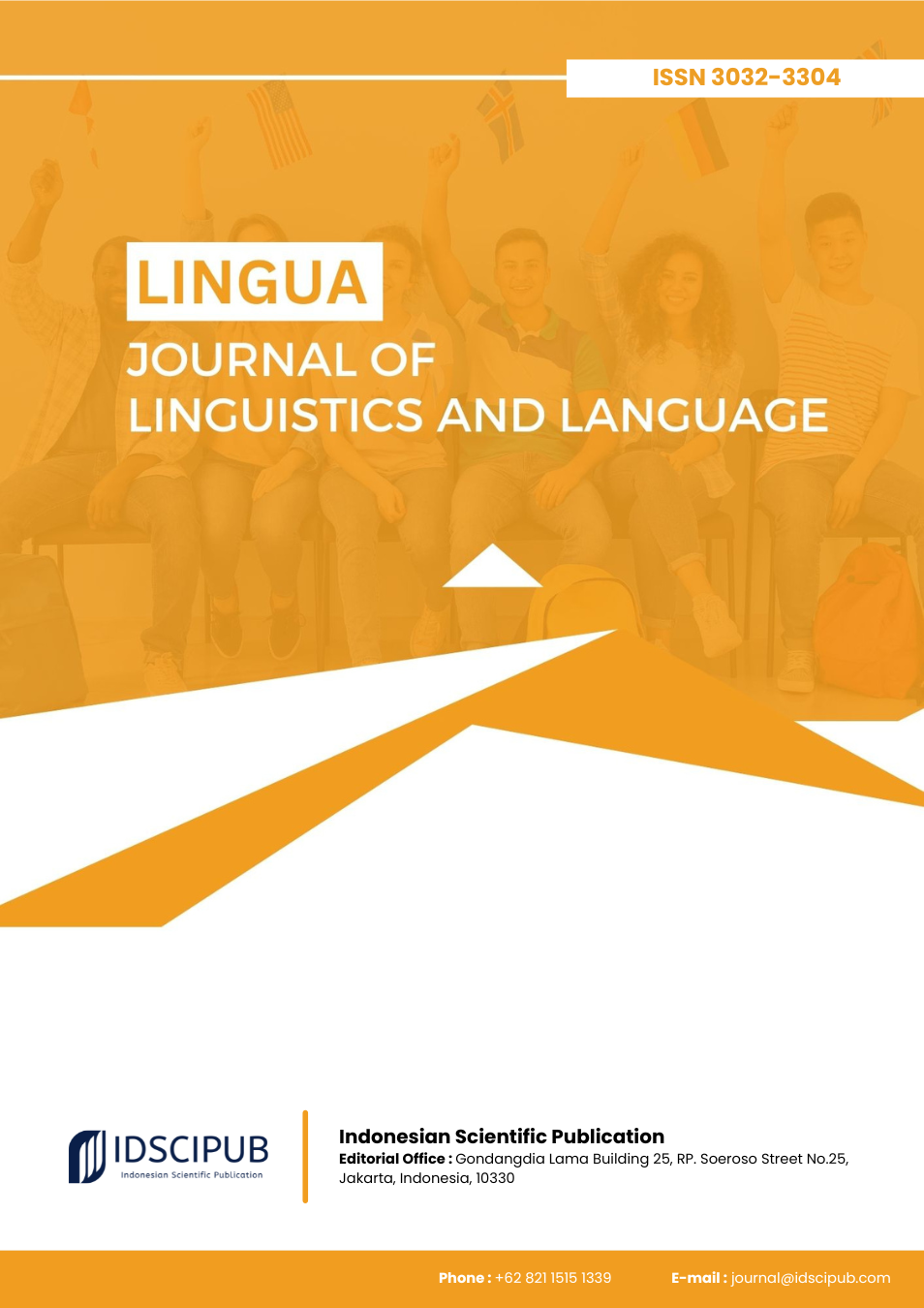Beyond the Hidden Curriculum: Gender, Textbooks, and Educational Equity
DOI:
https://doi.org/10.61978/lingua.v3i1.1037Keywords:
Gender Representation, Language Textbooks, Gender Bias, Critical Discourse Analysis, Education Equity, Heteronormativity, Inclusive CurriculumAbstract
This study presents a narrative review of gender representation in language textbooks, examining how male and female characters are depicted across diverse educational and cultural contexts. The review aimed to identify patterns of underrepresentation, role stereotyping, and heteronormativity, as well as to explore how systemic factors shape textbook content. A systematic literature search was conducted in Scopus, Web of Science, and Google Scholar using targeted keywords and Boolean combinations. Inclusion criteria focused on peer-reviewed studies from 2010 to 2025 that analyzed gender representation in language textbooks through content analysis, discourse analysis, or mixed methods. The findings reveal persistent gender imbalances, with men more frequently represented in professional and public domains, while women are marginalized or confined to domestic roles. Cross-national comparisons demonstrate that such disparities are more pronounced in developing countries but also persist globally, including in contexts with progressive policies. Furthermore, heteronormativity remains dominant, with LGBTQ+ identities largely absent from textbook narratives. These outcomes underscore the gap between policy commitments to gender equity and entrenched cultural, political, and religious influences in education. Addressing these challenges requires curricular reforms, stronger enforcement of gender-sensitive guidelines, and teacher training to critically engage with biased materials. Future research should broaden geographic scope, adopt intersectional perspectives, and investigate digital learning environments. By highlighting both persistent inequities and potential avenues for reform, this review emphasizes the importance of inclusive and equitable textbooks in shaping learners’ identities and opportunities.
References
Ahmad, M. and Shah, S. (2019). A critical discourse analysis of gender representations in the content of 5th grade english language textbook. International and Multidisciplinary Journal of Social Sciences, 8(1), 1. https://doi.org/10.17583/rimcis.2019.3989 DOI: https://doi.org/10.17583/rimcis.2019.3989
Alkhadra, W., Shahzadeh, Y., & Kabarity, A. (2022). Gender disparity in school textbooks in jordan: the case of arabic and social education in grades 4, 5, and 6. Dirasat Human and Social Sciences, 49(3). https://doi.org/10.35516/hum.v49i3.1376 DOI: https://doi.org/10.35516/hum.v49i3.1376
Awal, A. (2024). Gender representation in english language textbooks in bangladesh. Studies in Linguistics Culture and FLT, 12(2), 62-82. https://doi.org/10.46687/kokb5598 DOI: https://doi.org/10.46687/KOKB5598
Bose, P. and Gao, X. (2022). Cultural representations in indian english language teaching textbooks. Sage Open, 12(1). https://doi.org/10.1177/21582440221082102 DOI: https://doi.org/10.1177/21582440221082102
Cecilia, R., Ojeda, J., & Marín-Macías, C. (2020). Analysis of heteronormativity and gender roles in efl textbooks. Sustainability, 13(1), 220. https://doi.org/10.3390/su13010220 DOI: https://doi.org/10.3390/su13010220
Crawfurd, L., Saintis-Miller, C., & Todd, R. (2024). Sexist textbooks: automated analysis of gender bias in 1,255 books from 34 countries. Plos One, 19(10), e0310366. https://doi.org/10.1371/journal.pone.0310366 DOI: https://doi.org/10.1371/journal.pone.0310366
Dalle, A., Jabu, B., & Rimang, S. (2023). Gender equality in the foreign language textbooks of indonesian junior high schools. International Journal of Language Education, 7(2). https://doi.org/10.26858/ijole.v7i2.48497 DOI: https://doi.org/10.26858/ijole.v7i2.48497
Dar, S. and Bano, S. (2023). A discursive exploration of gender in primary textbooks of english in pakistan. International Journal of Comparative Education and Development, 25(1), 54-68. https://doi.org/10.1108/ijced-06-2022-0046 DOI: https://doi.org/10.1108/IJCED-06-2022-0046
Fithriani, R. (2022). Gender stereotypes in educational texts: a comparative study of indonesian and international primary english textbooks. Discourse and Interaction, 15(2), 53-76. https://doi.org/10.5817/di2022-2-53 DOI: https://doi.org/10.5817/DI2022-2-53
Islam, K. and Asadullah, M. (2018). Gender stereotypes and education: a comparative content analysis of malaysian, indonesian, pakistani and bangladeshi school textbooks. Plos One, 13(1), e0190807. https://doi.org/10.1371/journal.pone.0190807 DOI: https://doi.org/10.1371/journal.pone.0190807
Jehle, A., Groeneveld, M., Rozenberg, T., & Mesman, J. (2024). The hidden lessons in textbooks: gender representation and stereotypes in european mathematics and language books. European Journal of Education, 59(4). https://doi.org/10.1111/ejed.12716 DOI: https://doi.org/10.1111/ejed.12716
Khalid, Z. and Ouahmiche, G. (2019). Gender positioning in the visual discourse of algerian secondary education efl textbooks: critical image analysis vs teachers’ perceptions. Journal of Language and Linguistic Studies, 15(3), 773-793. https://doi.org/10.17263/jlls.631510 DOI: https://doi.org/10.17263/jlls.631510
Koster, D. and Litosseliti, L. (2021). Multidimensional perspectives on gender in dutch language education: textbooks and teacher talk. Linguistics and Education, 64, 100953. https://doi.org/10.1016/j.linged.2021.100953 DOI: https://doi.org/10.1016/j.linged.2021.100953
Kuraedah, S., Gunawan, F., Alam, S., Ubaidillah, M., Alimin, A., & Fitriyani, F. (2023). Gender representation in government-endorsed arabic language textbooks: insights from indonesia. Frontiers in Education, 7. https://doi.org/10.3389/feduc.2022.1022998 DOI: https://doi.org/10.3389/feduc.2022.1022998
Medawattegedera, V. (2017). Representing women ‘our way’: an english language teaching television programme in sri lanka. Society and Culture in South Asia, 4(1), 94-122. https://doi.org/10.1177/2393861717730621 DOI: https://doi.org/10.1177/2393861717730621
Salami, A. and Ghajarieh, A. (2015). Culture and gender representation in iranian school textbooks. Sexuality & Culture, 20(1), 69-84. https://doi.org/10.1007/s12119-015-9310-5 DOI: https://doi.org/10.1007/s12119-015-9310-5
Sunderland, J. (2018). Inclusion and exclusion in foreign language education: a critical overview, with illustrations from studies of a german classroom for young secondary learners and of five polish textbooks. International Journal of Applied Linguistics, 29(3), 308-321. https://doi.org/10.1111/ijal.12241 DOI: https://doi.org/10.1111/ijal.12241
Syed, G. and Agha, N. (2019). Representation of gender in the secondary school sindhi textbooks of pakistan. Asian Journal of Social Science, 47(4-5), 566-580. https://doi.org/10.1163/15685314-04704007 DOI: https://doi.org/10.1163/15685314-04704007
Taqdir, T. (2025). Cultural stereotypes in foreign language textbooks: a systematic review of visual representation. Theory and Practice in Language Studies, 15(6), 1949-1958. https://doi.org/10.17507/tpls.1506.23 DOI: https://doi.org/10.17507/tpls.1506.23
Vijayaratnam, P., Manoocherzadeh, M., Mim, F., Ahmed, F., Mohiuddin, M., & Gholipour, H. (2025). Gender representation and its impact on the quality of education: a comparative analysis of eft textbooks for grade six (2022 vs. 2024 editions). Forum for Linguistic Studies. https://doi.org/10.30564/fls.v7i4.8332 DOI: https://doi.org/10.30564/fls.v7i4.8332






